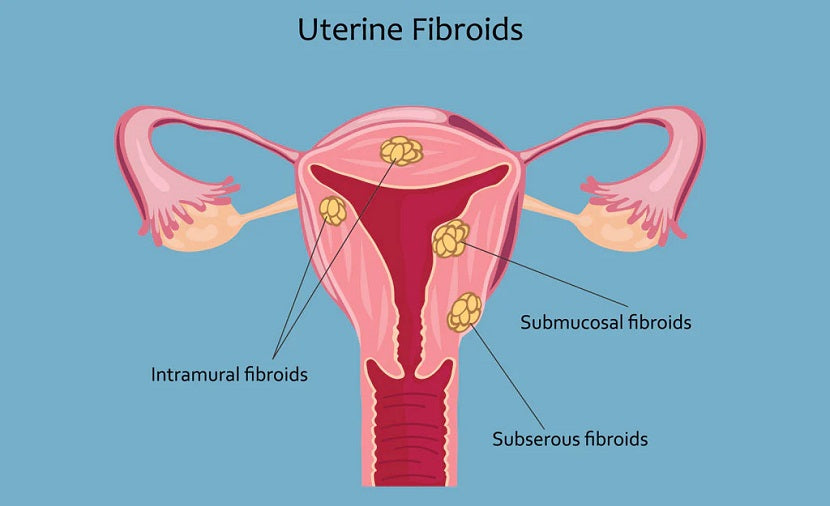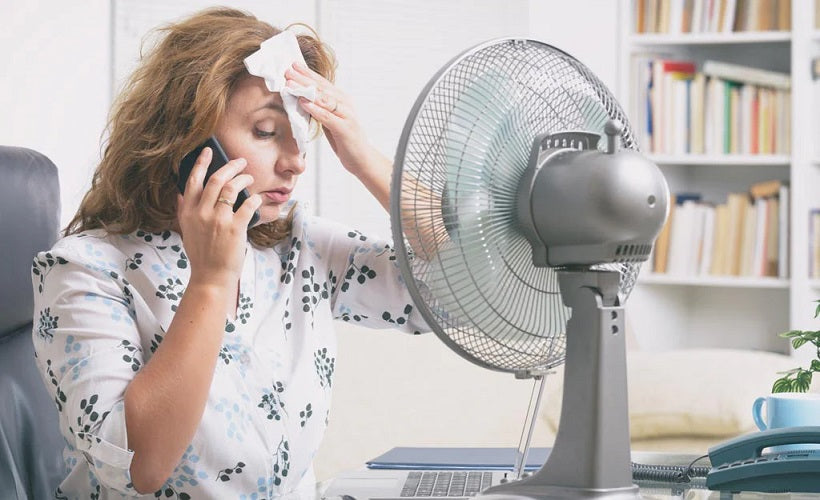Fibroids: A Comprehensive Guide
By Rachel Enright

What are fibroids?
Fibroids, also known as uterine fibromyomas, leiomyomas or myomas, are non-cancerous growths or lumps of muscle tissue that form within the walls of the uterus. Fibroids can vary in growth, from the size of a small bead to that of a large grapefruit (sometimes even bigger).
The hormones oestrogen and progesterone play a significant role in stimulating the growth of fibroids. Fibroids can multiply and grow when the hormones are imbalanced, particularly when oestrogen is dominant.
Fibroids develop most often when women are in their reproductive years and can continue until the onset of menopause. Afterwards, they tend to shrink and may slowly disappear because of a decrease in the production of oestrogen and progesterone during menopause.
By the age of 40, almost half of Australian women have one or more fibroids and up to 70% will have them by the time they reach 50.
Fibroid risk factors
- A family history of fibroids
- Early onset of menstruation
- Obesity
- Insulin resistance
- Age
- Polycystic ovarian syndrome (PCOS)
- High blood pressure
Signs & symptoms of fibroids
Often women have fibroids that remain undetected. Some discomfort and symptoms you may experience include painful, long and heavy periods, spotting between periods, pelvic pressure or discomfort during sex. The size and bulk of your fibroids may also cause swelling in your lower abdomen and place pressure on your lower back, bladder and/or bowel.
Women with fibroids often have anaemia (a reduction in your red blood cells leading to low iron). This is particularly true if fibroids cause an excessive loss of menstrual blood. Some symptoms of anaemia can include extreme fatigue, pale skin and shortness of breath. Other complications can cause bladder and bowel problems. These happen when large fibroids cause your uterus to bulge and press against your pelvic area and organs, causing bloating and/or discomfort, constipation or the need to pee often.
Fibroids & pregnancy
Fibroids can compromise your fertility if they interfere with the implantation of a fertilised egg – the egg may try to implant on top of a fibroid or have difficulty implanting because the fibroids have changed the shape of your uterus.
During pregnancy, fibroids that cause pressure on the placenta can reduce placental blood flow, causing a risk of miscarriages and premature babies. Fibroids that grow in the lower part of your uterus can affect delivery if they block the baby as it moves down your birth canal. This can increase your risk of a caesarean section.
Generally, if fibroids aren't causing any problems they don't require treatment; they simply need to be monitored. If they are large or causing discomfort, it’s best to talk with your doctor.

Natural ways to reduce fibroids
Avoid and reduce the following:
- Red meat and processed meats
- Dairy from cows which may contain steroids and other hormones that can affect your fibroid growth
- Refined sugar which can cause inflammation
- Alcohol which contains toxins and contributes to liver blockages
- Caffeine which slows the detoxification pathways and puts stress on the liver
Increase consumption of the following:
- Cruciferous vegetables that help with balancing hormones and clearing oestrogens
- Green leafy vegetables that are high in nutrients to support strong blood production and help reduce inflammation (Include veggies rich in iron to help with anaemia)
- Organic foods to help eliminate pesticides and chemical residues that contribute to fibroids
- Healthy fats like avocado, flax seeds, hemp seeds, and fish which can be helpful in balancing hormones
- Nutrient-dense foods high in vitamin C and beta-carotene such as berries, pumpkin, and carrots to help promote regrowth of healthy tissue and improve the immune system
How HAPPY HEALTHY YOU can help
Our bodies possess an innate capacity for healing and regeneration, but they require a nurturing environment to thrive. While this concept is straightforward, many struggle to cultivate the conditions necessary for optimal health and wellness.
The Happy Healthy YOU guide provides a comprehensive roadmap, outlining the essential practices and pitfalls to avoid on your journey towards vibrant health. You can seamlessly integrate positive choices into your daily routine, paving the way for improved well-being.
As you embrace these changes, you'll experience a revitalizing transformation – increased energy, restful sleep, and sustainable weight management. Ultimately, this guide empowers you to take control of your health, steering it towards a path of vitality and fulfillment.
The outlook on fibroids
Overall, fibroids can be managed and prevented naturally through a healthy lifestyle and diet. Studies have shown daily exercise can contribute to the prevention of fibroids. Food and natural herbs can also be helpful remedies for fibroids. If fibroids are something you are dealing with, we highly recommend to book in with one of our Naturopaths for a consultation on how to better manage your symptoms.
REFERENCES
Dalton-Brewer N. (2016). The Role of Complementary and Alternative Medicine for the Management of Fibroids and Associated Symptomatology. Current obstetrics and gynecology reports, 5, 110–118.
https://www.ncbi.nlm.nih.gov/pmc/articles/PMC4859848/
Islam et al. (2014). Use of dietary phytochemicals to target inflammation, fibrosis, proliferation, and angiogenesis in uterine tissues: promising options for prevention and treatment of uterine fibroids?. Molecular nutrition & food research, 58(8), 1667–1684.
https://www.ncbi.nlm.nih.gov/pmc/articles/PMC4152895/
Eunice Kennedy Shriver National Institute of Child Health and Human Development, NIH, DHHS. (2018). What are the risk factors for uterine fibroids? Washington, DC: Office of Communications.
https://www.nichd.nih.gov/health/topics/uterine/conditioninfo/Pages/people-affected.aspx
Wong JY, Gold EB, Johnson WO, and Lee JS. (2016). Circulating Sex Hormones and Risk of Uterine Fibroids: Study of Women's Health Across the Nation (SWAN). The Journal of Clinical Endocrinology & Metabolism. Jan; 101(1): 123–130.
https://www.ncbi.nlm.nih.gov/pmc/articles/PMC4701845/








Leave a comment
This site is protected by hCaptcha and the hCaptcha Privacy Policy and Terms of Service apply.